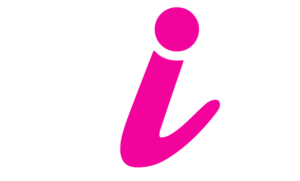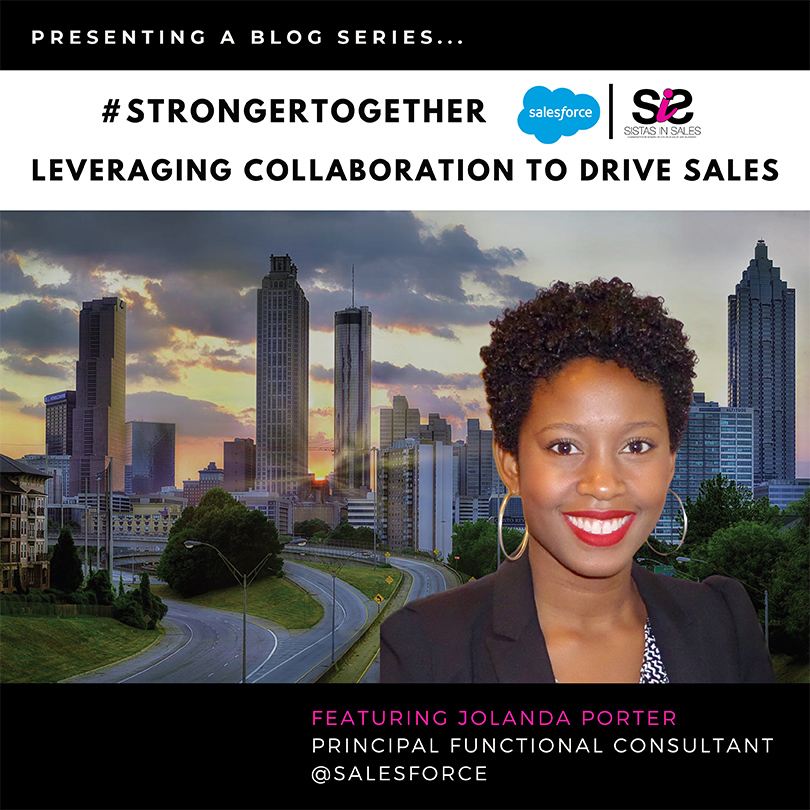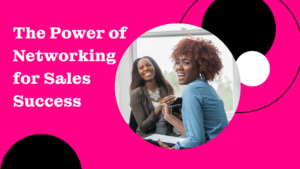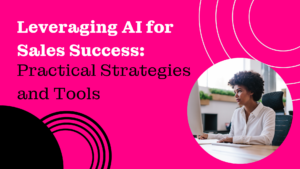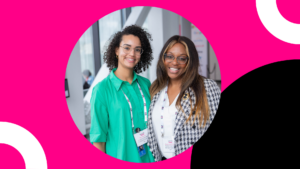The key to success in today’s sales environment is the ability to empathetically connect with customers. By leveraging insights gained through collaboration with clients, teams are able to tailor solutions that fit clients’ changing and specific needs. With that in mind, I met with Principal Functional Consultant, Jolanda Porter, to learn about her success with post-sales implementations.
Jolanda is part of Salesforce’s strategic services team that focuses on advisory and implementation projects. She has worked on Salesforce’s solutions that are designed for nonprofits and educational institutions and her job is to go to the customers first, do discovery, work with them to decide what the implementation will look like, and execute the build.
Q: How do you establish a trusting client relationship?
A: One of the first things I do is meet with the major stakeholders in a project to make sure we’re on the same page. I want to ensure that what was originally outlined in the sales process is accurate and aligns with what is being done. I ask the customer questions like “What does your organization need? Why do you need it? Who will be using it? What obstacles might you face and what can I do to help?” Establishing a connection is a huge part of having successful engagements.
Before coming to Salesforce, I was in the nonprofit space for fifteen years and worked closely with consultants. I know what it’s like to have consultants come in and feel like they don’t understand what you’re looking for. And I know what it’s like when a topline manager makes a decision for end-users without getting the users’ input. My goal is to ensure customers are delighted with the implementation process and that we’re working toward their goals.
Q: What role do you play in the sales cycle?
A: I am often solutioning. One of the things that happens when you focus on solutioning is that you establish trust with a customer. You can help customers understand that your objective is to make their job easier by taking their organization or business to the next level. When that conversation happens, other ideas emerge organically from that process.
Frequently, when we’re doing an implementation, we’ll identify new requirements or a different perspective to a pain point that can be helpful for the customer. Many times, this can lead to the introduction of a new solution and product. When you’re actively listening to a customer during an implementation, you’re getting much more detail than you would otherwise. Also, it is as important to listen to what they’re not telling you as much as what they are. It is our job to see the problems and the missing pieces. It’s common that we’ll discover new solutions that will help further our clients’ goals throughout the process.
Q: How did you make the shift from the nonprofit space to tech implementations?
A: I was in the nonprofit space for quite a long time. Anybody who knows the nonprofit world knows that you wear a thousand hats and there are never enough people. When we were introduced to Salesforce in 2008, we needed someone to be the administrator, and I was already tech-savvy, so I volunteered. I am the kind of person who is going to learn a skill if nobody else in the office knows it. Through this initial introduction to Salesforce, my interest in the connections between leadership, technology, and data grew, and over time I became the Director of Evaluation. I quickly became a person that other nonprofits came to with questions about Salesforce and data because I didn’t just understand the product, but I also understood what it was like to be the organization using the product.
Fast forward to 2016, I was a Deputy Director reaching the point in my nonprofit career where I’d probably become an executive director (ED), but I didn’t want to be an ED. I liked collaboration. I liked technology. I really liked Salesforce, and I really liked data, so I decided to go back to school to bridge the gap between my nonprofit background and the business world.

After graduating from NYU’s Stern School of Business with my master’s in business analytics, I decided I was ready to make the switch to tech. Many of my classmates took jobs at Google, Facebook, and Twitter, but I had a nonprofit heart. I was looking for a tech company with a social impact vision.
My peers discouraged this saying, “There’s no way you’re going to be doing socially good work and technology without going into the corporate space.” And then RoundCorner found me.
RoundCorner was the first Salesforce.org Platinum App Partner for the nonprofit market in North America. It provided fundraising solutions and industry expertise to meet the needs of the largest global organizations in the social sector.
My first projects were with the ACLU and National Geographic – I was getting to work with some of the world’s most influential nonprofits. Ironically, soon after I was hired, RoundCorner was acquired by Salesforce.org and I haven’t looked back. Today, I am thankful to work for a company that believes in and encourages mission-driven work while providing cutting-edge technology.
Q: That’s a big career change! Tell me about what it took to successfully make this shift.
A: It took drive and knowing my own talents, as well as learning how to be okay with being uncomfortable.
When people think of technology, sometimes they are intimidated, especially when there’s no one who looks like you. You think, “What skill can I bring to the table?” Yes, there are going to be baseline technical skills, but that’s something you can gain. I wanted to be more experienced in data analytics, so I got a master’s degree, and I specifically put myself in a program where I was surrounded by computer scientists. I knew I had the talent to succeed, but I had to get comfortable being uncomfortable and learning what I did not know. Today I use Trailhead as my go-to resource for keeping my skills up to date. It is my first recommendation as a learning tool for introducing new users to the myriad of capabilities Salesforce can offer.
Q: Congratulations on making that leap. What has been your experience as a Black woman in the tech industry?
A: The reality is, if you’re a woman of color in tech, you have to be brave because you might be going at it solo in the beginning. Many companies have affinity groups — like BOLDforce at Salesforce, an employee resource group for the Black community and our allies — to help foster community, but you may still experience moments where you’re not sure how you belong and that’s okay. I believe that women of color have the ability to enter any space, make themselves known, and show others that they deserve to be there.
On my current team, I’ve found that I’ve brought a new, real-world perspective to my teammates’ understanding of the nonprofit space. My change management experience has been invaluable to the implementation process, and I am constantly leveraging my management experience to help us navigate complex client needs.
I have learned that many times, what really stops us from getting to where we want to go is a fear that we won’t be accepted or be able to do the job, not the reality of the opportunity. So, if you can push past that obstacle, you’ll see how far you can truly go in your career or with any endeavor.
Q: What’s the one piece of advice that you wish you’d known when you were thinking about your career transition?
A: Figure out the job you want to have. Find people who have that job and ask what they did to get there. If I’m that person for someone reading this article, send me an email and I’ll connect with you.
I know it sounds really simple, but that’s one thing I love to do now that I’m at Salesforce. Whenever somebody reaches out to me, especially women of color, I love the chance to connect. They say, “I saw you on LinkedIn. Would you talk to me?” Absolutely! I will always make time to talk – everybody has thirty minutes. You will gain so much and learn so many shortcuts by talking to somebody who’s already doing what you want to do. You may think you need another degree, more years in the field, or a certification to make your move, but the obstacles you imagine may not truly be an issue.
One of the major qualities I’ve seen at Salesforce that makes people so successful is a high level of humility. Salesforce hires incredibly smart people, but everybody still asks questions. Everyone seems to be okay knowing that they can’t possibly know everything and all of us benefit from that culture.
A Seat At The Table

In addition to being a Salesforce trailblazer, Jolanda had a seat at the table for the Sistas In Sales Soft Launch dinner party in 2018 where she met Chantel George, founder and CEO of SIS. Jolanda and Chantel met when Jolanda was being interviewed for a CRM manager position at Dataminr (where Chantel was an account executive at the time), and although Jolanda moved forward with Roundcorner, the recruiter insisted that the two meet. Chantel invited Jolanda to her SIS Launch dinner! It’s amazing how one conversation led to so many new connections.
– Cherilynn
Chief Learning Officer, SIS
Cherilynn Castleman, Sales Keynote Speaker/Trainer/Executive Coach, has been a sales executive for 20+ years. With her natural talent for teaching and a drive to sell, Cherilynn uses her skills to coach and train other executives and sales professionals.

Sistas in Sales, LLC (SIS) is a community for women of color sales professionals to network, advance their careers and most importantly, find sisterhood – offering events, thriving Slack community with companies hiring now, and career coaching services. Learn more about Sistas In Sales membership here, connect with us on LinkedIn, Instagram, Facebook, and Twitter.

Sponsored by Salesforce
Learn more about joining Salesforce
